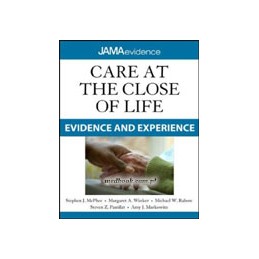- Obniżka


 Dostawa
Dostawa
Wybierz Paczkomat Inpost, Orlen Paczkę, DHL, DPD, Pocztę, email (dla ebooków). Kliknij po więcej
 Płatność
Płatność
Zapłać szybkim przelewem, kartą płatniczą lub za pobraniem. Kliknij po więcej szczegółów
 Zwroty
Zwroty
Jeżeli jesteś konsumentem możesz zwrócić towar w ciągu 14 dni*. Kliknij po więcej szczegółów
Publishers Note:: Products purchased from Third Party sellers are not guaranteed by the publisher for quality, authenticity, or access to any online entitlements included with the product.
From one of the worlds leading medical journals comes the definitive evidence-based, full-color guide to end-of-life and palliative care
A new addition to the JAMAevidence series, Care at the Close of Life:: Evidence and Experience offers evidence-based and clinical expert guidance on caring for patients with life-limiting illness, incorporating the words and perspectives of affected patients, their families, and treating clinicians.
Organized by these actual clinical cases, the book is based on the acclaimed 7-year series of 42 articles, originally published in JAMA as “Perspectives on Care at the Close of Life,” and now thoroughly updated as chapters and featuring extensive never-before-published material. Care at the Close of Life covers are a wide range of clinical syndromes, disease processes, communication challenges, health-care delivery settings, and issues faced by patients, including withdrawal of dialysis and other life-sustaining measures, cross-cultural approaches, and the role of chemotherapy. Throughout the book, emphasis is on the principles of palliative care, with the patient and family at the center of care, and with attention given to all problems—physical, psychological, social, and spiritual.
Reflecting this focus, each chapter begins with a patient case study to introduce the clinical problem, followed by “perspectives” that draw on extensive, real-world dialogue between clinicians, patients, and families. Internationally renowned authors then review the typical challenges illustrated by the case, offering state-of-the-art, evidence-based assessment and treatment approaches.
Features
Fully revised and updated text with new evidence and references, including the search methodology for each chapters updateEvidence-based orientation presents the current state of knowledge in the care of terminally ill patients and support for their families and caregiversPractical clinical guidance and approaches from international experts in palliative care Self-assessment Q&A, for reinforcing your knowledge of each chapters content and for preparing for examsA useful Glossary of acronyms, terms, and tests Updated Resources for each chapter offer current, authoritative sources of diagnostic and treatment information that can help you optimize palliative careMedline PubMed ID numbers facilitate quick, convenient access to referencesOpis
